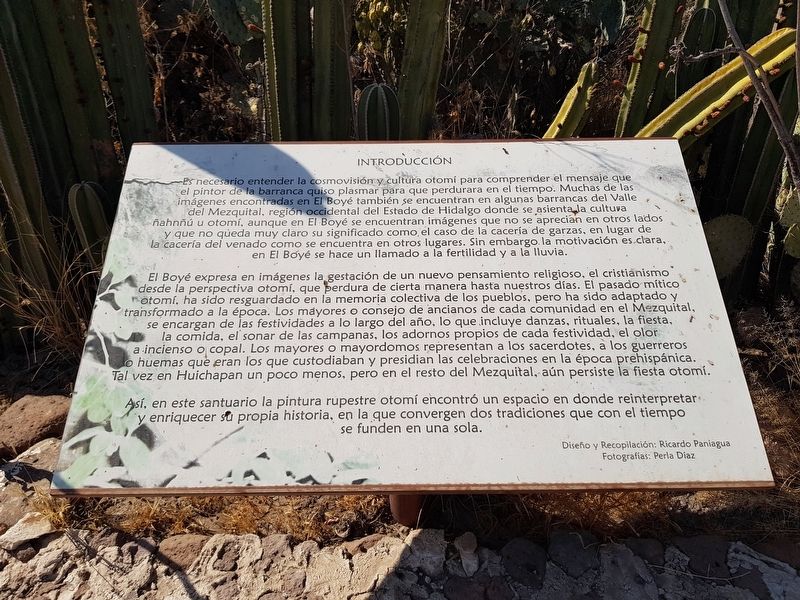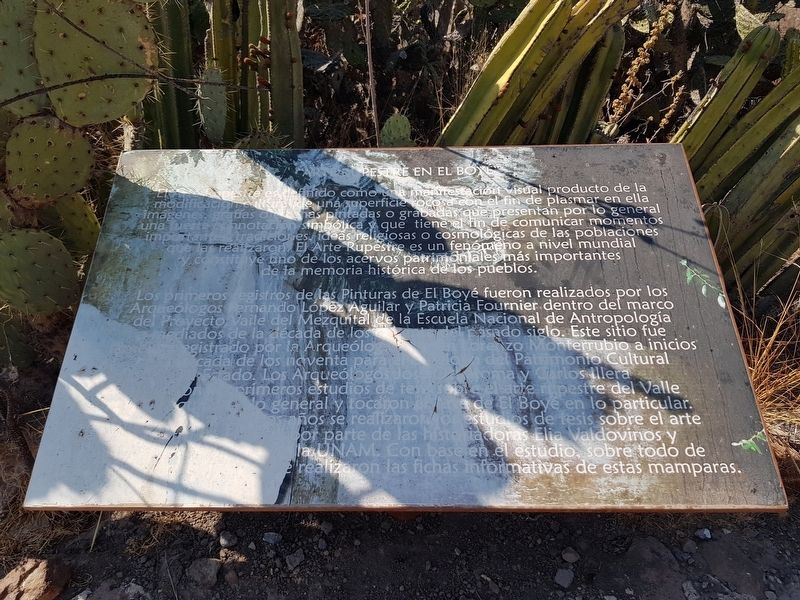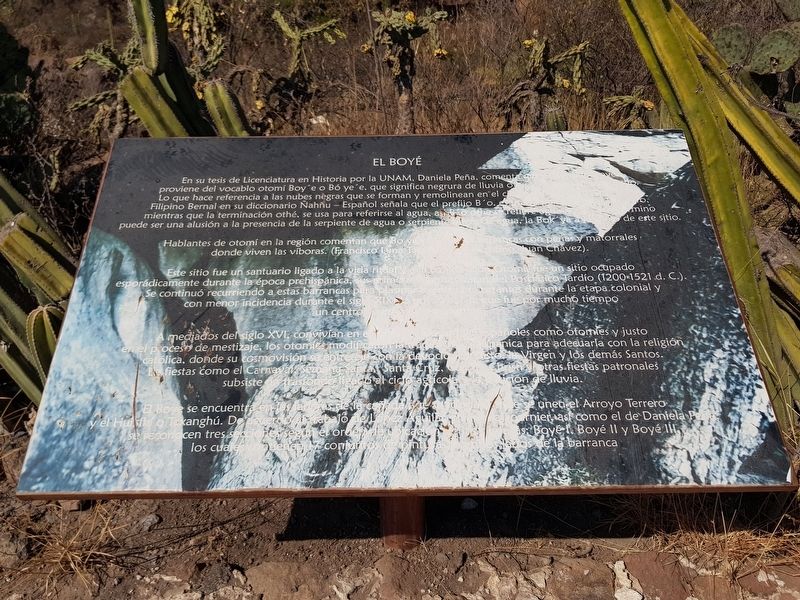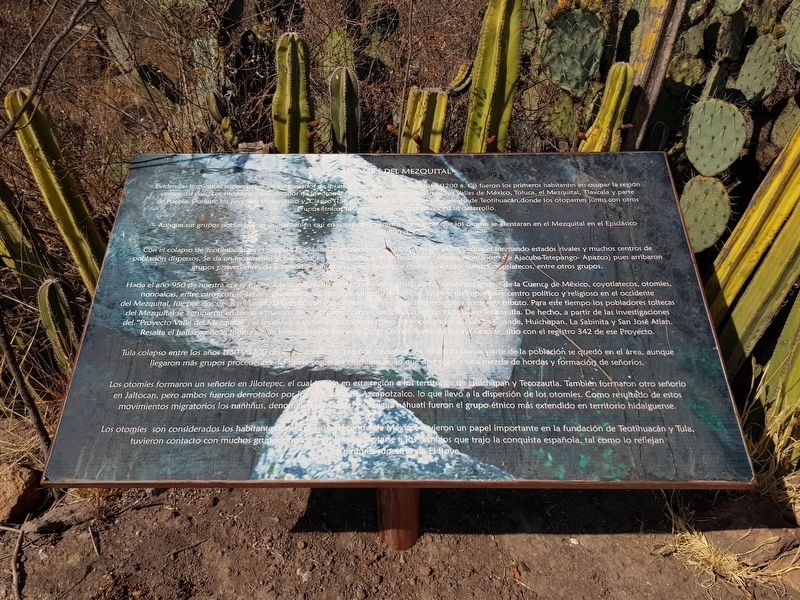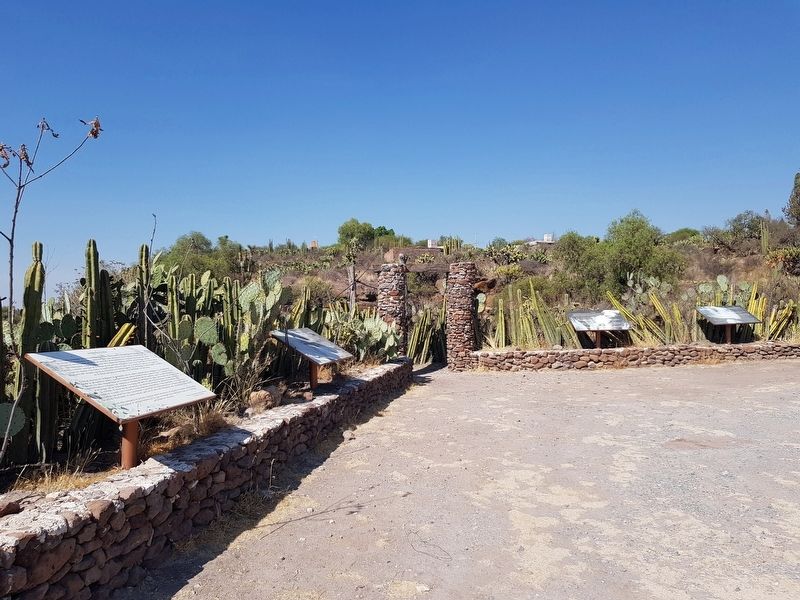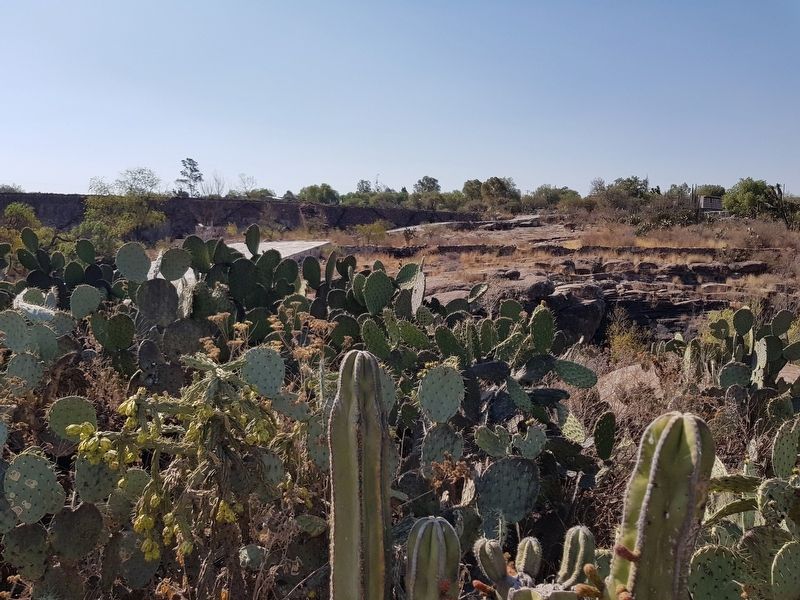El Boyé in Huichapan, Hidalgo, Mexico — The Central Highlands (North America)
El Boyé Rock Art
Introducción
Es necesario entender la cosmovisión y cultura otomí para comprender el mensaje que el pintor de la barranca quiso plasmar para que perdurara en el tiempo. Muchas de las imágenes encontradas en El Boyé también se encuentran en algunas barrancas del Valle del Mezquital, region occidental del Estado de Hidalgo donde se asienta la cultuva ñahnñú u otomí, aunque en El Boyé se encuentran imágenes que no se aprecian en otros lados y que no queda muy claro su significado como el caso de la cacería de garzas, en lugar de la cacería del venado como se encuentra en otros lugares. Sin embargo, la motivación es clara, ΕΙ Boyé se hace un llamado a la fertilidad y a la lluvia.
El Boyé expresa en imágenes la gestación de un nuevo pensamiento religioso, el cristianismo desde la perspectiva otomí, que perdura de cierta manera hasta nuestros días. El pasado mítico otomí, ha sido resguardado en la memoria colectiva de los pueblos, pero ha sido adaptado y transformado a la época. Los mayores o consejo de ancianos de cada comunidad en el Mezquital, se encargan de las festividades a lo largo del año, lo que incluye danzas, rituales, la fiesta, la comida, el sonar de las campanas, los adornos propios de cada festividad, el olor a incienso o copal. Los mayores o mayordomos representan a los sacerdotes, a los guerreros o huemas que eran los que custodiaban y presidian las celebraciones en la época prehispánica. Tal vez en Huichapan un poco menos, pero en el resto del Mezquital, aún persiste la fiesta otomí.
Así, en este santuario la pintura rupestre otomí encontró un espacio en donde reinterpretar y enriquecer su propia historia, en la que convergen dos tradiciones que con el tiempo se funden en una sola.
Diseño y Recopilación: Ricardo Paniagua
Fotografias: Perla Diaz
“Arte Rupestre en Boyé”
El Arte Rupestre es definido como una manifestación visual producto de la modificación cultural de una superficie rocosa con el fin de plasmar en ella imágenes, grafias o escenas pintadas o grabadas que presentan por lo general una fuerte annotacion simbólica y que tiene el fin de comunicar momentos importantes, tradiciones, ideas religiosas o cosmológicas de las poblaciones que las realizaron. El Arte Rupestre es un fenómeno a nivel mundial constituye uno de los acervos patrimoniales más importantes de la memoria histórica de los pueblos.
Los primeros registros de las Pinturas de El Boyé fueron realizados
por los
Arqueologos Fernando López Aguilar y Patricia Fournier dentro del marco
de Proyecto Valle del Mezquital de la Escuela Nacional de Antropología
a mediados de la década de los viente del pasado siglo. Este sitio fue
registrado por la Arqueóloga Carmen Lorenzo Monterrubio a inicios
de la decada de los noventa para el Catalogo del Patrimonio Cultural
del Estado. Los Arqueólogos José Ochatoma y Carlos Illera
hicieron los primeros estudios de tesis sobre el arte rupestre del Valle
del Mezquital en lo general y tocaron el arte de El Boye en lo particular.
… años se realizaron estudos de tesis sobre el arte … por parte de las historiadoras Elia Valdovinos y … la UNAM. Con base en el estudio, sobre todo de … realizaron con las fichas informativas de estas mamparas.
El Boyé
En su tesis de Licenciatura en Historia por la UNAM, Daniela Peña, comenta que la palabra Boyé proviene del vocablo otomí Boy'e o Bó ye'e, que significa negrura de lluvia o lugar donde llueve mucho. Lo que hace referencia a las nubes negras que se forman y remolinean en el … Filipino Bernal en su diccionario Ñahñu - Español señala que el prefijo B'o, es usado … mientras que la terminación othé, se usa para referirse al agua, así B’o othe se refiere agua …camino puede ser una alusión a la presencia de la serpiente de agua o serpiente agua, la Bok’ya a lo largo de este sitio.
Hablantes de otomí en la región comentan que Bo yé … barrancas con peñas y matorrales donde viven las víboras. (Francisco Luna … Cristino, Juan Chávez).
Este sitio fue un santuario ligado a la vida ritual y a la cosmovisión Otomí fue un sitio ocupado esporádicamente durante la época prehispánica, sus primeros pinturas datan del Posclásico Tardío (1200-1521 d.C.). Se continuó recurriendo a estas barrancas para plasmar eventos importantes durante la etapa colonial y con menor incidencia durante el siglo XIX que fue por mucho tiempo un centro …
A mediados del siglo XVI, convivían en el … españoles como otomies y justo en el proceso de mestizaje, los otomies modificaron la tradición prehispánica para adecuarla con la religión católica, donde su cosmovisión se entreteje con la devoción de Cristo, la Virgen y los demás Santos. En fiestas como el Carnaval, Semana Santa, Santa Cruz, Corpus Cristi y otras fiestas patronales subsiste un trasfondo ligado al cicio agrícola y la petición de lluvia.
El Boyé se encuentra en las afueras de la cañada que … se unene el Arroyo Terrero y el Huisfhi o Taxanghú. De acuerdo al trabajo de Lopez Aguilar … Fournier, asi como el de Daniela Peña, se reconcen tres secciones según el orden de ubicación de las pinturas: Boyé I, Boyé II y Boyé III, los cuales contienen 17 conjuntos de pinturas así a los lados de la barranca
Los Otomíes
del Mezquital
Evidencias linguísticas sugieren que los antepasados de los otomíes, durante el Preclásico (1200 a.C.) fueron los primeros habitantes en ocupar la región centro del país. Los otopames, antepasados de los otomíes furon la major población en los Valles de México. Toluca, el Mezquital, Tlaxcala y parte de Puebla. Durante los periods Protoclásico y Clásico (150 a.C. a 600 d.C.) se da el surgimento de Teotihuacán, donde los otopames junto con otros grupos étnicos tuvieron un papel importante en su desarrollo.
Aunque sus grupos poblacionales se mantenían casi en constante migración, es posible que los otomís se asentaran en el Mezquital en el Epiclásico (600-900 d.C).
Con el colapso de Teotihuacán en el periódo Epiclásico la población se distribuyó en los Valles Centrales formando estados rivales y muchos centros de población dispersos. Se da un incremento poblacional en el Mezquital y en la Teotlalpan (sistema montañoso de Ajacuba-Tetepango-Apazco) pues arribaron grupos provenientes de la región teotihuacana pero de sangre otomí conocidos como Coyotlatecos, entre otros grupos.
Hacia el año 950 de nuestra era se forma Tula como reguardo de la alianza y arribó de los diferentes grupos de la Cuenca de México, coyotlatecos, otomíes, nonoalcas, entre otros, con toltecas y chichimecas de filiación náhuatl a la cabeza. Tula fue un importante
centro político y religioso en el occidente del Mezquital, fue por dos siglos un centro de poder que expandía militarmente su territorio para conseguir tributo. Para este tiempo los pobladores toltecas
del Mezquital se agruparon en torno a manantiales y arroyos, como sucedió en la región Huichapán Tecozautla. De hecho, a partir de las investigaciones del “Proyecto Valle del Mezquital”, se localizaron various sitios como los encontrados en Sabina Grande, Huichapan, La Sabinita y San José Atlan. Resalta el hallazgo de la tumba de un jerarca toltece llamado Ocho Ojo de Reptíl en Sabina Grande, sitio con el registro 342 de ese Proyecto.
Tula colapso entre los años 1150 y 1200 debido a conflictos internos crecientes, sin embargo buena parte de la población se quedó en el área, aunque llegaron más grupos procedentes del norte como los chichimecas, lo que da origen a una mezcla de hordas y formación de señorios.
Los otomíes formaron un señorío en Jilotepec, el cual incluía en esta región a los territorios de Huichapan y Tecozautla. También formaron otro señorío en Jaltocan, pero ambos fueron derrotados por Azcapotzalco, lo que llevó a la dispersión de los otomíes. Como resultado de estos movimientos migratorios los ñanhñus, denominación otomíes en lengua náhuatl fueron el grupo étnico más extendido en territorio hidalguense.
Los otomíes son considerados
los habitante mas antiguos del Centro de México, tuvieron un papel importante en la fundación de Teotihuacán y Tula, tuvieron contacto con muchos grupos étnicos y supieron adaptarse a los cambios que trajo la conquista española, tal como lo reflejan las pinturas rupestres de El Boyé.
Introduction
It is necessary to understand the worldview and Otomí culture in order to understand the message that the ravine artists wanted to capture so that it would endure in time. Many of the images found in El Boyé are also found in some ravines of the Valley of the Mesquital, the western region of the State of Hidalgo where the culture Ñahnñú or Otomí is based, although in El Boyé there are images that are not seen elsewhere and that do not have a clear meaning for us today. An example is the image of heron hunting, instead of the deer hunt found elsewhere. However, the motivation is clear, as Boyé makes a call to fertility and rain.
El Boyé expresses in images the gestation of a new religious thought, that of Christianity from the Otomí perspective, which endures in a certain way to this day. The mythical Otomí past has been protected in the collective memory of the people, but it has been adapted and transformed to the ...
"Rock Art in Boyé"
Rock art is defined as a visual manifestation resulting from the cultural modification of a rocky surface in order to capture images, photographs or painted or engraved scenes that usually present a strong symbolic annotation and which is intended to communicate important moments, traditions, and the religious or cosmological ideas of the populations that made them. Rock Art is a worldwide phenomenon that is one of the most important types of heritage of the historical memory of peoples.
The first records of the paintings of El Boyé were made by the archaeologists Fernando López Aguilar and Patricia Fournier within the framework of the Valle del Mezquital Project of the National School of Anthropology in the mid-1960s. This site was registered by the archaeologist Carmen Lorenzo Monterrubio in the early 1990s for the Catalog of the Cultural Heritage of the State. Archaeologists José Ochatoma and Carlos Illera did the first thesis studies on the rock art of the Valley del Mezquital in general and the art of El Boyé in particular. ... years theses on rock art were done ... by historians Elia Valdovinos and ... UNAM. Based on these studies, especially from ... made with the facts shown on these markers.
El Boyé
In her thesis in history at the UNAM, Daniela Peña comments that the word Boyé comes from the Otomí word Boy'e or Bó ye'e, which means “blackness of rain” or “place where it rains a lot”. This could refer to the black clouds that form and swirl in the… Filipino Bernal in his Dictionary Ñahñu - Spanish indicates that the prefix B'o is used… while the ending othé is used to refer to water, so B 'o othe refers to water… path may be an allusion to the presence of the water snake, the Bok'ya along this site.
Otomí speakers in the region comment that Bo yé… ravines with rocks and bushes where vipers live. (Francisco Luna… Cristino, Juan Chávez).
This site was a sanctuary linked to ritual life and the Otomí worldview. It was a site sporadically occupied during pre-Hispanic times. Its first paintings date from the Late Postclassic (1200- 1521 AD). These ravines continued to be used to capture important events during the Colonial period and with less incidence during the 19th century, as it was a center for a long time…
In the middle of the 16th century, Spaniards lived together with Otomíes and during this process, the Otomíes modified the pre-Hispanic tradition to adapt it to their religion. The Catholic religion included interwoven traditions with the devotion of Christ, the Virgin and the other Saints. In festivals such as Carnival, Holy Week, the Holy Cross, Corpus Cristi and other patron saint festivities, there remains a background linked to the agricultural cycle and the request for rain.
El Boyé is located on the outskirts of the ravine that… joins the Arroyo Terrero and the Huisfhi or Taxanghú. According to the work of Lopez Aguilar ... Fournier, as well as that of Daniela Peña, three sections are recognized according to the order of location of the paintings: Boyé I, Boyé II and Boyé III, which together contain 17 sets of paintings on either side of the canyon.
The Otomíes of the Mezquital
Linguistic evidence suggests that the ancestors of the Otomí during the Preclassic (1200 BC) were the first inhabitants to occupy the central region of the country. The Otopames, ancestors of the Otomi, were the largest population in the Valleys of Mexico. Toluca, El Mezquital, Tlaxcala and part of Puebla. During the Protoclassic and Classic periods (150 BC to 600 AD), the emergence of Teotihuacán occurred, where the Otopames, along with other ethnic groups, played an important role in its development.
Although their population groups were in almost constant migration, it is possible that the Otomís settled in the Mezquital in the Epiclassic (600-900 AD).
With the collapse of Teotihuacán in the Epiclassic period the population was distributed in the Central Valleys forming rival states and many dispersed population centers. There was a population increase in the Mezquital and in the Teotlalpan (Ajacuba-Tetepango-Apazco mountain system) as groups from the Teotihuacan region arrived. They were of Otomí blood and known as Coyotlatecos, among other groups.
Around the year 950 of our era, Tula was formed as a stronghold for the alliance and the different groups of the Basin of Mexico arrived: Coyotlatecos, Otomíes, Nonoalcas, among others, with Toltecs and Chichimecas of Nahuatl affiliation at the head. Tula was an important political and religious center in the west of the Mezquital and for two centuries it was a center of power that militarily expanded its territory to gain tribute. By this time the Toltec settlers of the Valley of Mezquital were grouped around springs and streams, as also happened in the Huichapán-Tecozautla region. In fact, from the investigations of the "Valle del Mezquital Project", various sites were located, such as those found in Sabina Grande, Huichapan, La Sabinita and San José Atlan. The discovery of the tomb of a Toltec hierarch named Ocho Ojo de Reptíl (Eight Eyes of a Reptile) in Sabina Grande, site with record 342 of that project, stands out.
Tula collapsed between the years 1150 and 1200 due to increasing internal conflicts, however a good part of the population stayed in the area, although more groups came from the north such as the Chichimecas, which gives rise to a mixture of hordes and the formation of smaller, but powerful, groups.
The Otomí formed a dominion in Jilotepec, which included the territories of Huichapan and Tecozautla. They also formed another dominion in Jaltocan, but both were defeated by Azcapotzalco, which led to the dispersion of the Otomí. As a result of these migratory movements, the Ñanhñus, an Otomí denomination in the Nahuatl language, were the most widespread ethnic group in the State of Hidalgo.
The Otomí are considered the oldest inhabitants of Central Mexico. They had an important role in the founding of Teotihuacán and Tula, they had contact with many ethnic groups and they knew how to adapt to the changes brought about by the Spanish conquest, such as is reflected in the cave paintings of El Boyé.
Topics. This historical marker is listed in these topic lists: Anthropology & Archaeology • Arts, Letters, Music • Native Americans.
Location. 20° 24.22′ N, 99° 37.907′ W. Marker is in El Boyé, Hidalgo, in Huichapan. Marker is on Unnamed Road just north of Carretera Ixmiquilpan-Huichapan (Route 45), on the right when traveling west. Touch for map. Marker is in this post office area: El Boyé HGO 42434, Mexico. Touch for directions.
Other nearby markers. At least 8 other markers are within 5 kilometers of this marker, measured as the crow flies. General Julián Villagrán and José María Villagrán (approx. 3.3 kilometers away); The Chapel of the Third Order (approx. 3.6 kilometers away); The Chapel of the Virgin of Guadalupe (approx. 3.6 kilometers away); Franciscan Ex-Convent (approx. 3.7 kilometers away); Monolithic Cross of the Atrium (approx. 3.7 kilometers away); Parroquia de San Mateo Apóstol (approx. 3.7 kilometers away); General Julián Villagrán (approx. 3.7 kilometers away); El Chapitel (approx. 3.7 kilometers away).
Credits. This page was last revised on March 20, 2021. It was originally submitted on March 20, 2021, by J. Makali Bruton of Accra, Ghana. This page has been viewed 80 times since then and 9 times this year. Photos: 1, 2, 3, 4, 5, 6. submitted on March 20, 2021, by J. Makali Bruton of Accra, Ghana.
